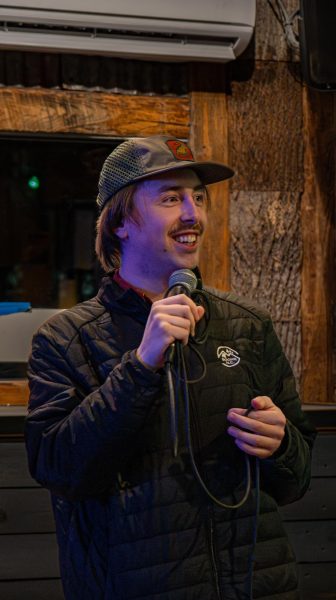OPINION: Purdue Pharma and the Opioid Epidemic
January 24, 2019
In today’s pop culture, there is no shortage of shows and movies about drug cartels in foreign countries, addicting the U.S. to their drugs and becoming filthy rich in the process. However, the 1990s are over, and today’s opioid epidemic is made in the U.S. Its chief architect is the Sackler family and their drug company, Purdue Pharma.
Should Netflix’s popular show “Narcos” continue its northward journey from Colombia and Mexico to create “Narcos: U.S.,” our cartel equivalent, albeit non-violent, will be the Sackler family. The drug is not cocaine; it’s OxyContin.
Founded in 1952 by brothers Arthur, Mortimer and Raymond Sackler in Yonkers, New York, and currently headquartered in Stamford, Connecticut, Purdue Pharma brings in $3 billion annually in revenue. The Sackler family is worth $14 billion, according to Forbes.
Purdue Pharma released its new form of the painkiller oxycodone, branded OxyContin, in 1996. Purdue salesmen began pitching and cozying up to doctors around the country, particularly in rural and blue-collar areas where chronic pain is common. The salesman told doctors the drug would not be addictive and had low potential for abuse because it was designed to slowly release throughout the day. Patients would not get high, but still experience relief. The “wonder drug” would not have the “peaks and valleys” of other painkillers.
However, the drug’s effect dissipated quicker than expected, leading to increased prescriptions. People still experienced peaks and valleys. The pill could be crushed and snorted for an immediate high. Mass addiction quickly followed.
From 1995-96, the number of painkiller prescriptions jumped by 8 million — the “blizzard of prescriptions” the Sacklers hoped for. The Drug Enforcement Administration described the campaign as the most aggressive marketing campaign for an opioid in U.S. history. Its pioneer was Arthur Sackler.
Opioid deaths more than doubled from 1999-2010, the vast majority coming from prescription non-synthetic painkillers, according to the Centers for Disease Control and Prevention.
In Pennington Gap, Virginia, which “Dopesick” author and journalist Beth Macy called the “ground zero” of the opioid epidemic, one pharmacist knew immediately what was happening when Purdue salesmen arrived in the small Appalachian town about 85 miles northeast of Boone to market the new drug.
“They are marketing this as non-addicting, and it’s going to be one of the most addictive drugs we have on the market,” the pharmacist said, according to “Dopesick.” “It’s going to destroy us.”
In 2007, Purdue and three top executives pleaded guilty to misrepresenting the dangers of OxyContin and paid a $635.6 million fine, the largest ever by a pharmaceutical company. However, the Sacklers were not accused of any wrongdoing and have not faced any personal consequences.
However, ProPublica found that at least two of three executives, former CEO Michael Friedman and former legal counsel Howard Udell, took $3 million and $6 million respectively from the company to be the fall guys, according to a heavily redacted civil complaint.
The complaint alleges that Purdue was spending millions to “keep the loyalty of people who know the truth.”
A recent court filing stated that Purdue Pharma failed to alert authorities after reports of the drugs’ addictive nature and rampant abuse. The filing states that Richard Sackler, Purdue president from 1999-2003, oversaw the strategy to shift all blame to the addicts.
“We need to hammer on the abusers in every way possible,” Sackler wrote in an email in 2001, according to the court documents.
“This is not too bad, it could have been far worse,” Sackler wrote to company officials after finding out 59 people had died in a single state in 2001.
The CDC has found that on average 130 Americans die every day from an opioid overdose. Estimates vary, but anywhere between 200,000 and 400,000 people have died from opioid overdose since 1996. Only in 2015 did illegal synthetic opioids overtake prescription opioids as the lead killer. Prescription opioids still kill more than heroin, even after heroin deaths spiked in 2010.
It was in 2010, 15 years after OxyContin’s release, that Purdue Pharma reformulated the drug to be more resistant to abuse and less addictive. Abuse rates dropped and overdose deaths from prescription opioids leveled out, but opioid addiction rates and deaths have continued to skyrocket. Those addicted to OxyContin and other prescription drugs switched to cheaper, more powerful alternatives like heroin and fentanyl to stave off dope sickness.
As addiction grew, Purdue sensed an opportunity and embarked on a secret project to expand into the “attractive market” of addiction treatment in 2014. Taking a more sympathetic stance than Richard Sackler, Purdue attempted to become an “end-to-end pain provider.”
The initiative fizzled out, but Richard Sackler was still issued a patent for an addiction treating drug.
In 2017, almost 20 years and countless deaths after OxyContin’s first release, Purdue Pharma stated that it would stop marketing the drug to doctors in the U.S. The Sacklers being thrust into the spotlight they long avoided by a torrent of lawsuits and bad press.
Make no mistake, attempting to enter the treatment market was not a benevolent act by Purdue to fix the crisis they created. Richard Sackler’s patent application still describes people who suffer from substance abuse as “junkies.” Rather, it was a way to make up for lost revenue as the press, courts and doctors became wiser to their deception.
As the opioid epidemic continues its spread from rural Appalachian towns to suburbs to inner-cities, do not blame the “junkies.” They are victims of a morally corrupt, much richer, much higher power, which used their well-being to get rich.
The next user-dealer that is convicted and sentenced to jail time as our laws struggle to place the appropriate blame should share a cell with a Purdue executive or Sackler family member and get out long before them.











